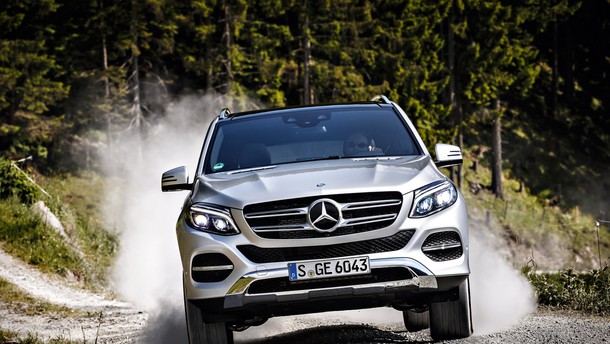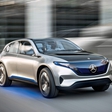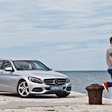
It´s the new 500 e from Mercedes, and it proves to be a winning cocktail, despite the tough completion it faces from day one, from its BMW X5 plug-in hybrid rival.
The new generation M Class has split into two categories: the GLE Coupe, which copycats the overall irrational but successful formula – mostly in the US, China and Middle East - of the BMW X6, and the GLE non-coupe, which just became the first Mercedes-Benz SUV propelled by a plug-in hybrid powertrain.

The two vehicles share the same rolling base, although the Coupe uses a wider rear track (since the body is 7 cm wider and 8 cm longer) which, in turn, is carry-over hardware from the previous generation, the ML, from which the German engineers have borrowed the body structure, the tracks and the wheelbase.
Once inside the GLE, we must praise the overall quality of materials and finishes, the wide seats with enhanced lateral support, as well as the comprehensive infotainment equipment (managed by the optional Command Online system, with a 20,3" TFT touch screen) we already know from the C, E and S Class models. The central monitor is one of the highlights of the ergonomically-correct cockpit, also beause it is well-integrated into the dashboard, unlike what we have seen in some Mercedes-Benz models on sale today.
The cabin offers generous room for five occupants (the rear seat is always willing to receive three occupants, and headroom in the rear is more than enough for 1.90 meters-tall passengers. The back of the rear seats may be asymmetrically folded, to create a flat floor and thus ratchet up the trunk volume from 480 to 1800 liters. Not bad, but still less than the 690-2010 liters offered by a non-PHV GLE, as the battery installation raises the boot floor, steals some volume...and forces your dog to jump a little higher, too...

There is no shortage of safety and driver assistance systems, as well as technology to improve road handling in any scenario. The Dynamic Select system allows you to choose between five different driving programs - Individual, Comfort, Slippery, Sport and Sport + - which intervene on various driving parameters, making it possible to combine very different driving experiences behind the wheel of just one vehicle. And for the first time in this segment, there is a fully electrically-operated extendable tow hitch, which is also dynamically "protected" with the ESP stabilization function.
All GLE 400 and 450 diesel and petrol are equipped with the new 9-speed automatic transmission which Mercedes is gradually putting in place of the 7-speed device that is still used in the remaining versions, including this plug-in hybrid. It includes the hybrid module, which makes it smoother and more pleasant to use than in the other applications, with the combustion engine versions. The permanent all-wheel drive (4Matic) contributes to the safe and sporty handling, with an equal distribution of torque (50:50) between front rear axles.

One other major help to improve stability is the pneumatic suspension, in combination with a new system which regulates the damping characteristics in a progressive and continuously variable way (ADS Plus). The interconnectivity of all these systems is the key to a remarkable change to the GLE 500 e's character: for instance, Dynamic Select changes the main parameters in the damping adjustment (in Sport+ mode the vehicle achieves maximum transverse stability, while in Comfort, the ride comfort is given full priority).
The active regulation of tilting in curves is another system that favors the handling competence when the driver chooses Sport or Sport+ programs, but it is not available for the 500 e.
This first experience behind the wheel of the new GLE 500 e took place in Tyrol, where we met different climatic and surface conditions, including torrential rain on the first day, a muddy and bumpy 4x4 stage prepared by Mercedes (with a GLE endowed with an Offroad package which, again, is not available for this plug-in hybrid version) and even a dry road segment on the second day. And always with air springs, and not the metallic ones which are standard in the less powerful versions (and on the PHV).
The work of the pneumatic suspension helps you to forget ythat ou are controlling a 5 meter long, 2-ton vehicle and, thanks to the driving modes, one that can go from rather stiff to reasonably comfortable for an urban daily use. Yet we could not avoid noticing two hick-ups on the drive selection system: on the one hand, it would be better to have a command that would not rotate endlessly to either side and, on the other hand, we missed an indication on the instrument panel which of the modes is selected, an absence that forces the driver to turn the rotary commander to find out which program is being used at each time.

In the off-road track, the GLE (diesel) proved to be Dakar Rally-ready, achieving impressive axes intersections with one or two airborne wheels, and crawling up and down some breathtaking gradients, easily left behind with the help of the downhill speed control system speed (2-16 km/h), transfer case, central differential lock, front and rear cameras (to visualize any obstacle), etc. In short, any inexperienced driver can easily become a qualified rough off-road expert behind the wheel of a GLE.

The PHV GLE uses the 333 ps 3.0 V6 biturbo petrol engine, in combination with a 116 HP electric motor (fed by the energy stored in a 8.8 kWh battery) to deliver the performance of a V8, with the consumption of a 4-cylinder diesel. Performances are impressive also if you put them into perspective: 5.3 s from 0 to 100 km/h means the gigantic GLE is a quicker sprinter than a Honda Civic Type R, even if it is not as thrilling and engaging to drive, of course (this is not the best quality of the Jumbo SUV from Mercedes, even compared to direct rivals, like the BMW X5 or the Porsche Cayenne, in their plug-in hybrid versions).

The system is the same as that used in the S500 PHV, even in the operating modes it provides: Hybrid (the system decides which power source to use and in what proportion), E-Mode (100% electric, available up to 130 km/h and over 30 km, provided there is no brisk acceleration, which will start the gas engine), E-save (to keep battery power for the end of the journey, possibly in an urban area) and Charge (to charge the battery by using the gas engine). The transitions between the different driving modes in the automatic program (Hybrid) are always very smooth, contributing to a rather pleasant and simple drive. Ride comfort is quite impressive, but one can only expect that the non-pneumatic suspension versions will definitely tend to show a more sensible body roll through corners. Inside the plug-in hybrid GLE, the main differences you will notice, compared to a non-PHV version, are related to the specific hybrid menus, which help you to monitor the instantaneous operation and the accumulated results of the plug-in hybrid drive system.
The fuel consumption of the GLE 500 e is at the same level as its rivals, the Porsche Cayenne S E-Hybrid and the BMW X5 xDrive40e, but these two candidates for the king of comfort provide a more engaging time behind the wheel. The new Volvo XC90 T8 Twin Engine is less thirsty, and will keep going in EV mode only (40 km) when the others already started to release smoke from the exhaust. If you compare the 500 e to a diesel alternative, inside the new GLE line-up you will find – depending on market – that it may cost some 10,000 euro more than the 350d, but a commuter tackling short distances on a daily basis may recover the initial investment faster than expected.



